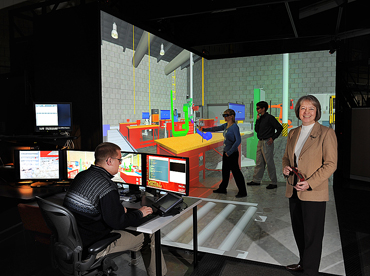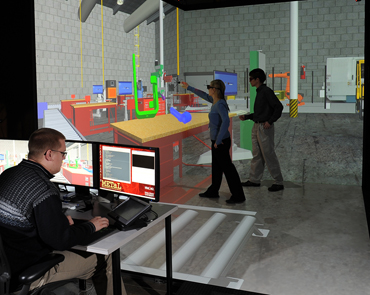Iowa State’s METaL lab develops multiple ways to experience virtual reality
12-06-11

Judy Vance, right, demonstrates a virtual factory in Iowa State University's METaL virtual reality facility. Working in the virtual factory are students, left to right, Leif Berg, Meisha Rosenberg and Ryan Pavlik. Larger photo. Photo by Bob Elbert.
Contacts:
Judy Vance, Mechanical Engineering, Virtual Reality Applications Center, Human Computer Interaction Graduate Program, 515-294-9474, jmvance@iastate.edu
Mike Krapfl, News Service, 515-294-4917, mkrapfl@iastate.edu
Iowa State’s METaL lab develops multiple ways to experience virtual reality
AMES, Iowa - Iowa State University doctoral students Leif Berg and Ryan Pavlik handed over a Wii Remote and a pair of 3-D glasses.
A visitor to Iowa State's newest virtual reality lab - METaL, the Multimodal Experience Testbed and Laboratory - took the tools and began walking the virtual floor of a factory. And there, to the left, were three, yard-long metal pieces ready for assembly.
Berg, who's studying human computer interaction, and Pavlik, who's studying human computer interaction and computer science, offered a few tips for operating in the virtual factory. And then it was time for some assembly work.
The big green frame piece went front and center. Then the smaller blue piece had to be turned and twisted into place, metal clangs marking each time the parts collided. Then, after lots of looks all around the parts and through the holes in their sides, a white pin finally lined up and went through both pieces.
"This lab is similar to what you'd find in industry," said Judy Vance, Iowa State's Joseph C. and Elizabeth A. Anderlik Professor of Engineering and a professor of mechanical engineering. "This is something we use often. We can run over here and fire it up. We can bring projects in here and work with them on a daily basis."
METaL, operating since February, is designed to be a versatile, everyday research tool. It's not meant to be C6, Iowa State's six-sided virtual reality laboratory. The C6 provides an extremely high resolution and fully immersive virtual environment through the use of 24 projectors and 48 computers. METaL provides a partial immersive environment with less equipment and a simpler configuration.
"We have three projectors and two walls and a floor," Vance said. "With one projector per surface, that makes it pretty simple."
Even so, projector technology has advanced rapidly in the last few years and can provide bright displays with adequate resolution. Take a closer look whenever text is displayed in METaL, Vance said. The letters are crisp and readable and the 3-D resolution is high enough to create an effective virtual reality environment.
"One of the reasons I like to work in this space is the ability to walk up to a virtual image of a 3-D object and explore it from many different angles," Vance said. "The physical sensation of moving your body provides you with additional spatial information about the products you are examining. The aspect of moving in the space makes it more real than standing here and flying towards it."
Vance said the lab will be used to study and develop the integration of 3-D visual display technology, audio effects and force feedback. The goal is to create natural interaction techniques in virtual reality. That could be used by industry to design new parts, explore design functionality or develop better assembly methods.
Another goal for the lab is to make virtual reality more accessible on campus. Vance said METaL will be a tool used by undergraduate researchers and one that reaches out to young students and prospective engineers. About 40 middle school and high school girls, for example, recently visited the lab to learn about virtual reality and engineering.
The lab was built with support from Iowa State, the College of Engineering, Iowa State's Institute for Physical Research and Technology and the department of mechanical engineering. The lab was built by Mechdyne Corp., a Marshalltown-based company founded by graduates of Iowa State and former graduate research assistants in Iowa State's Virtual Reality Applications Center.
Working with Vance to advance research in the lab are students in mechanical engineering, human computer interaction, computer science, and electrical and computer engineering. Graduate students in the lab include Berg, Patrick Carlson, Isaac Garlington, Tim Morgan and Pavlik. Undergraduates include Adam Carlson, Andrew Moore, Jane Peters and Meisha Rosenberg.
Those students are a key to one of Vance's long-term goals: to spread the use of virtual reality to industry.
"All these students see the value of virtual reality," she said. "And when they get jobs in industry, they'll say, 'We need to do virtual reality.'"

Students, left to right, Leif Berg, Meisha Rosenberg and Ryan Pavlik assemble parts in the virtual factory created by Iowa State's METaL virtual reality facility. Larger photo. Photo by Bob Elbert.
-30-